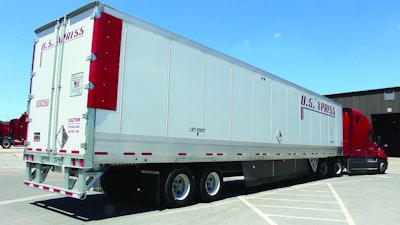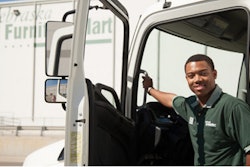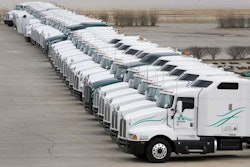
The three areas on a trailer where aerodynamic drag is the greatest are the front above the tractor’s air dam, the bogie and the negative pressure pocket behind the doors.
Much effort has been made to improve the aerodynamics of heavy trucks over the years, but the same can hardly be said for the trailer. While the improved airflow coming off the tractor has a positive impact on the box behind it, the responsibility of improving trailer drag has largely fallen on upfits and add-ons like skirts, tails and farings.
Generally, payback on trailer aero upfits falls under about 24 months, but the strategies used to attack those areas can vary, as can their impact on efficiency and overall effectiveness.
“Generally speaking, if you have one thing and then you add another thing, it’s not always a 1+1=2 all the time,” FlowBelow President Josh Butler says of compounding benefits of various devices.
“Two things that affect the same spot aren’t necessarily going to be additive,” adds SmartTruck CEO Steve Ingham.
There’s not much you can do with air once it hits a moving vehicle. Ingham says there are two basic ways to improve aerodynamics: redirect airflow or deflect it.
“The challenge of deflecting air is that it creates forces that have to be overcome,” Ingham says, “and the drag created by the structure to support the deflection is usually bigger than the benefit of the deflection.”
FlowBelow’s tractor AeroKit, which can trim fuel consumption by upwards of 2.5 percent, works with the trailer by filling in the gap between the truck’s drive axles. The kit’s rear panel, which is flared outward, helps the air jump the gap between the last fairing and the trailer skirt.
“It also helps to pull out the underbody flow of the truck,” Butler says. “In general, you’re trying to get that air out … and get it to go around the skirt. And most importantly, it prevents [air] from going under the skirts.”
According to the North American Council for Freight Efficiency’s Annual FleetFuel Study, fleets have flocked to trailer skirts en masse since 2008, with deployment of the devices reaching more than 80 percent over a six-year period.
By reducing aerodynamic drag under the trailer where air hits the rear axles, skirts streamline and guide air around the sides and to the back of the trailer for a fuel consumption reduction of about 5 percent.
Wabco’s OptiFlow SideWing, the company says, delivers up to 5 percent fuel savings and drops CO2 emissions by up to 3.8 tons per semi trailer per year.
Another familiar add-on, trailer tails slash another 5 percent of a tractor’s fuel consumption by creating a vacuum and sucking the air around the trailer’s rear corners before forcing air into the low-pressure pocket that causes rear drag. Prashanth Kamath, leader of Stemco’s Innovative Tire & Mileage Solutions segment, says tails provide perks beyond aerodynamics.
“It also goes a long way to increasing safety, stability and visibility,” he says. “It does a lot to streamline airflow and makes for smother drive, leading to lower driver fatigue.”
Tails and skirts can be combined for nearly 10 percent reduction in fuel consumption but for fleets struggling to decide between the two, Prashanth says choosing the industry’s most popular aero add-on is a logical first step.
“If you’ve got nothing, go with a skirt,” he says. “If you have a skirt, go with a tail. If you have a tail, go with an auto-deployment device [for the tail].”
Shaped like airplane wings and mounted to the trailer top and sides, SmartTruck’s TopKit work similar to a tail by compressing, accelerating and redirecting airflow around the rear corner of the trailer. Similarly, Ingham says TopKit can improve fuel mileage up to 5.5 percent on a 53-foot trailer.
“By pushing that flow around those corners,” Ingham says, “it fills that low-pressure pocket more effectively and makes the amount of low pressure that is pulling on those doors less.”
Late last year, the EPA shelved plans to include trailer efficiency in its Phase 2 Greenhouse Gas regulations that would have mandated all trailers use some combination of efficiency technologies, which could have included aero upfits and low rolling resistance tires among other options.












